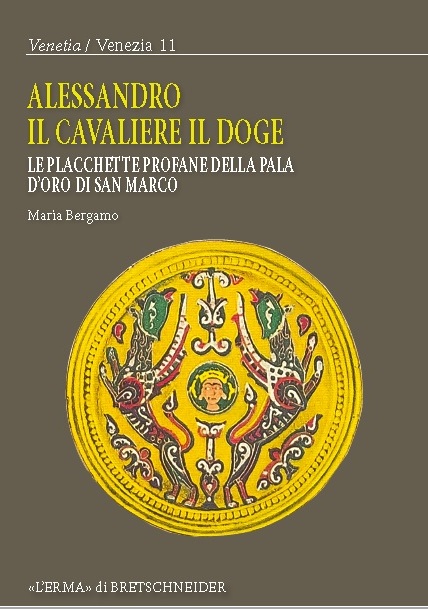Alessandro, il cavaliere, il doge. Le placchette profane della Pala d’Oro di San Marco
A Presentation of the book by Maria Bergamo
by Patricia Fortini Brown
Abstract

The jewel-encrusted Pala d’Oro in Venice’s Basilica di San Marco dazzles the viewer with its golden radiance and precious Byzantine enamels. It is hard to know where to look first, but our gaze is immediately drawn to the enamel of the Pantocrator enthroned in the central panel of lower section. Only then do we focus on the evangelists and archangels who surround him and the figures of Doge Ordelaffo Falier, the Virgin Orant, and the Byzantine Empress Irene flanked by two dedicatory inscriptions. Then perhaps we look at the upper section, with the Archangel Michael flanked by six large enamels depicting feast days of the Byzantine church, and then turn back to the lower section to scan the ranks of apostles, prophets, and saints who populate the niches across the surface. These are bordered on the top by scenes from the life of Christ and at the sides by small scenes from the life of St. Mark. Reassembled in the fourteenth century by Doge Andrea Dandolo, the precious palimpsest seems to bring heaven to earth.
It is all a little overwhelming. We might not even notice the small round plaquettes and busts of saints embedded in the surrounding cornice. But in this carefully researched study, Maria Bergamo directs our attention to six enamel Byzantine plaquettes, datable to the 11th century, embedded in the bottom border. Flanking a plaquette of the Virgin in the center, they measure only 4.4 cm in diameter and are easy to overlook: three knightly falconers on horseback, an apotheosis of Alexander the Great, a bust of the Emperor Constantine, and a symbol of the Cosmos (or cosmic vision, also identified as a Tree of Life). With little obvious coherence, the grouping has often gone unmentioned in the literature. But there are a few notable exceptions, and these formed the foundation for Bergamo’s more extensive study. André Grabar identified the plaquettes as profane products of the Macedonian renaissance and suggested that they might have been gifts from the imperial court to the Venetian doge. Renato Polacco interpreted the plaquettes as symbols of the Greco-Roman Empire, of which Venice was the heir. He further observed that they expressed the culture and political ideals of the dogate of Andrea Dandolo, who was responsible for the 1345 renovation of the Pala as the refulgent centerpiece of the Basilica of San Marco.
In her detailed and elegantly written, study, Bergamo expands upon these interpretations and shows how the plaquettes create a coherent narrative that provide an important key to the meaning of the Pala as a whole. After discussing falconry and the Byzantine, Muslim, and Western sources for the knights, she focuses on their relationship to the great eschatological narrative, both mystical and political, that begins with Creation or Pantocrator. The divinely inspired sequence is carried forward through the centuries by Alexander the Great, the Roman emperor Constantine, and the Byzantine emperors, to culminate in the Venetian republic. These little enamels function like footnotes, joining the heavenly vision above to political sovereignties over time and the earthly terrain of Dandolo’s Venice. Indeed, Bergamo shows how the ensemble was an integral part of the Pala, forming an elegant summa of Andrea Dandolo’s vision of the Venetian republic as the rightful – and inevitable – heir of the Roman empire.
 Abstract
Abstract
In the jewel-encrusted Pala d’Oro in Venice’s Basilica di San Marco, among its golden radiance and precious Byzantine enamels, there are six little plaquettes, only 4.4 cm in diameter: three knightly falconers on horseback, an apotheosis of Alexander the Great, a bust of the Emperor Constantine, and a symbol of the Cosmos (or cosmic vision, also identified as a Tree of Life). With little obvious coherence, the grouping has often gone unmentioned in the literature. Bergamo shows how the ensemble was an integral part of the Pala, made first by Doge Ordelaffo Falier, and reassembled in the fourteenth century by Doge Andrea Dandolo. Indeed, they form an elegant summa of Andrea Dandolo’s vision of the Venetian republic as the rightful – and inevitable – heir of the Roman empire.
keywords | Venice; Pala d’Oro; Andrea Dandolo; Alexander the Great; falconry.